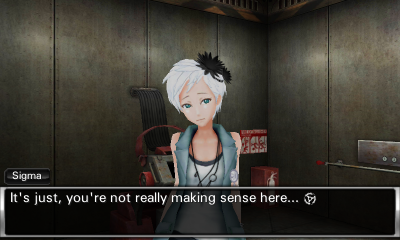Zero Escape: Virtue’s Last Reward is pretty much its predecessor, 999, combined with the Prisoner’s Dilemma. I’m pretty sure that only philosophy majors know what the prisoner’s dilemma is, so let me explain it with a more interesting story.
I recently went speed dating for the first time. I met with sixteen different girls, for four minutes each, and afterwards, I had to pick which girls I wouldn’t mind seeing again.
THIS WAS THE MOST STRESSFUL THING I HAVE EVER DONE IN MY ENTIRE LIFE.
Okay, not really, but it ended being an intense mind game. Should I pick Girl #6, even though I’m sure she didn’t like me? I wasn’t a fan of Girl #9, but I made her laugh a lot–did that mean she would pick me? Girl #12 would be a fantastic friend, but a horrible girlfriend–is it worth the risk to pick her and give her the wrong idea? And why did Girl #8 mysteriously disappear halfway through the event?
In the end, I went with the generous (read: desperate) route and picked “Yes” for half of the girls, and “No” for the other half. When the results came in, it turned out that a grand total of NONE of the girls I picked decided to pick me back. I immediately followed my three-step plan for dealing with girls:
And that, my friends, is just what Virtue’s Last Reward is like. All nine participants in the Nonary Game are divided into six groups, and at the end of every round, you have to decide whether to vote “yes” or “no” for your partner.
The best scenario, of course, is if you both pick yes. The worst scenario is when you pick yes, and your partner picks no. And just like speed dating, half of the time, you pick the wrong answer and you get a game over sequence, in which you die alone and unloved.
That’s not an exaggeration. In most endings, someone dies. In most bad endings, it’s you. Except for the one weird ending, where your character dies, but not really. I wonder why he never played his “get out of death” cheat card during the other 20 or so endings.

The biggest complaint about the previous game in the series was that the endings were a complete and utter mess. The game followed a series of rather random rules like “pick Door #2 third, and you get stabbed with a knife.” Figuring out how to get the good ending was near-impossible without GameFAQs.
Virtue’s Last Reward completely does away with that broken system. Instead, it has a flowchart that automatically keeps track of every pathway you’ve been on. Better yet, you can instantly jump from one pathway to another. So, for example, if I’m not sure whether I want to pick Luna or not, I can play the “you said no to Luna” pathway for five minutes, decide it’s boring, then immediately switch over to the “you said yes to Luna” pathway. I don’t have to restart the game from the beginning in order to see the alternate paths. This is a much, MUCH better system than the first game.
The “skip through dialogue you’ve seen before” system is also much improved, in that it actually works all of the time now, not just part of the time. The only (minor) downside to the new system is that there are a few locks, which block off certain pathways. For example, until you see the Clover ending, the K ending is blocked, forcing you to solve the endings in a particular order. So the new system is not as open-ended as it could be, but it’s still a humongous improvement over the first game.
Besides the game system being better, the actual storyline is better. It’s much larger and complex, with many twists and turns. In the end, you still have to deal with some ridiculous things along the lines of time-traveling clones with psychic powers, but the story is more coherent and well-done this time around. Congrats to the game makers for the huge improvement on an already-interesting plot.
The voice acting for this game is good. The characters are…well, to be honest, I liked the characters in the first game more. Some characters, like Luna and Quark, don’t contribute to the game at all, unless you’re trying to unlock their endings. Clover is a fine character, even if she acts nothing at all like she did in the first game. Other characters feel like repeats from the first game, like “big guy with amnesia,” “jerk” and “scantily-clad woman who doesn’t really contribute to the plot.”
Which brings me to my next point. The main character in this game is a pervert, and he’s not the only one. Compared to the first game, they turned the perv level up by 50%. It’s all for the sake of humor, though. At least, I hope it is. Maybe the guy who wrote this game is just a sicko. Anyway, just a heads-up to potential players: This game has a ton of dirty jokes. If you’re the kind of person who enjoys bloody murder games, but can’t stand innuendos, stay away from this one.
The puzzles are, by and large, more interesting than the previous game. They come in normal mode, for gamers who like a challenge, and Paul Franzen mode, for babies who don’t want to actually think while solving puzzles. There are more puzzles, and the variety of puzzles is better, too, although I really hate that overly-difficult dice puzzle that gets used too much (“too much” being defined as “at least once”).
All in all, Zero Escape: Virtue’s Last Reward is a huge improvement over the previous game, 999. In fact, it’s kind of painful to go back and replay the first game, after playing the second one. They did a good job with this one, and now I’m looking forward to the third game in the series.



So I guess this means I should get it then…
I really enjoy your site’s youtube walkthrough of 999 and it saved me from playing it, as it was a game people were saying has a lot of annoying technical problems (principally having to replay puzzles, which I don’t enjoy as much as the story sections). I just finished virtue’s last reward and I agree it was better than 999 (it definitely is) but I don’t think you give the story enough credit. First of all, the time-travel endings were very coherent within the parameters set by the game- it is probably the most sophisticated time-travel story I’ve seen since Primer or Donnie Darko. There are no time-traveling psychic clones in the game, by the way, though their are clones as well as other people who can see the future and influence the past. One thing about the game that really deserves appreciation is the integration of real philosophical and scientific concepts to create a conceivable reality. Schrodinger’s Cat, the Chinese Room, and social economics (Prisoner’s Dilemma) are beautifully illustrated and explored so well that I feel genuinely edified, even somewhat enlightened by this game in a way that few games or other entertainment media have done. I also thought the clever use of the color wheel to constrain team selection was much better than the digital root technique of the first game. Incidentally, though I thought that your speed-dating analogy was very funny, the prisoner’s dilemma is really not exactly like speed dating unless you assume that girls would rather reject someone who wants to date them than to be in a mutually desired relationship. I’m sure some girls are like that, but then who would want to date them?
They clearly put a lot of thought into the time travel segment, but I’m not sure I like it. The illustration explaining it could have been better; it’s hard to follow the turns of the timeline’s pathway. I suppose it’s hard to explain how to linerally time travel to non-linear points on the timeline.
Like the previous game, I feel the philsophical thought experiments were explored, but not brought to a satisfactory conclusion. All the game does is pose questions like “should you ally or betray?” or “is the cat alive or dead?”. Nobody bothers to actually answer those questions; they just raise them. Any amateur philsopher can ask questions; only a real philosopher can answer them.
The color wheel totally threw me off, to be honest. That’s not the color wheel I learned in elementary school…
From what I can tell, the speed dating analogy is wholly accurate. Girls tend to have higher standards than boys, so they are more likely to reject in a scenario where boys accept. The story about eight girls picking “no” when I said “yes” is 100% true.
I’m probably wrong but I was thinking that the colour wheel was actually referred to coloured lighting or the visible spectrum, maybe? (example, red light + blue light = magenta – seeming as it fit’s between pink and purple)